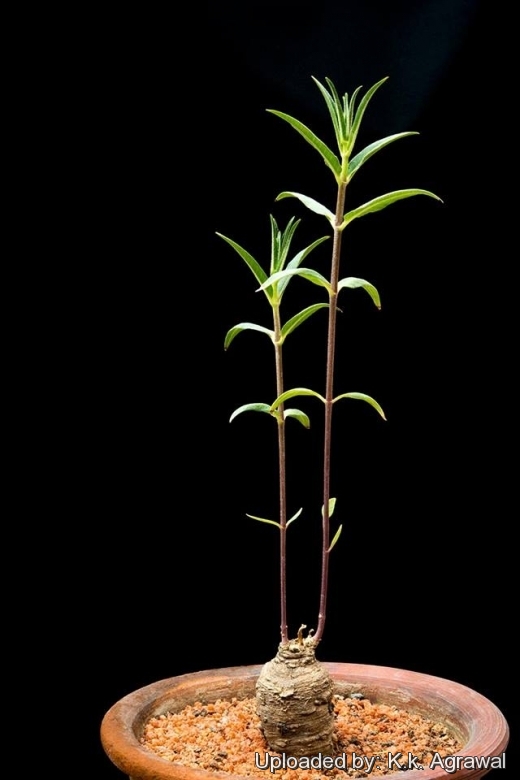
Stathmostelma fornicatum subs. tridentatum Photo by: K.k. Agrawal
Origin and Habitat: Tanzania.
Habitat and ecology: Stathmostelma fornicatumSN|31722]]SN|31722]] subs. Tridentatum grows dotted between grass in Brachystegia woodland.
Synonyms:
See all synonyms of Stathmostelma fornicatum
Description: The typical Stathmostelma fornicatumSN|31722]]SN|31722]] is a perennial herb with annual stems arising from stout, perennial, subterranean root tubers (geophytic). The flowers are bright yellow with a slight greenish tinge.
Stathmostelma fornicatumSN|31722]]SN|31722]] subs. Tridentatum: subs. Tridentatum differs from ssp. fornicatum for having 2 mm long tooth-like inner appendage in corona lobes.
Annual stems: Erect to 35 cm tall.
Flowers: Sepals green, sometimes tinged purple at tip; petals bright yellow, particularly on upper surface. Corona-lobes with 2 long tooth-like inner appendage (± 2 mm long).
Remarks: Tuber stains drying paper purplish-black.
Subspecies, varieties, forms and cultivars of plants belonging to the Stathmostelma fornicatum group
 Stathmostelma fornicatum (N.E.Br.) Bullock: is a perennial herb with annual stems arising from a perennial root tuber. Flowers yellow with 1 or 2 small teeth in the cavity of the corona lobes. Distribution: Zambia, Tanzania, Malawi, Mozambique and Zimbabwe.
Stathmostelma fornicatum (N.E.Br.) Bullock: is a perennial herb with annual stems arising from a perennial root tuber. Flowers yellow with 1 or 2 small teeth in the cavity of the corona lobes. Distribution: Zambia, Tanzania, Malawi, Mozambique and Zimbabwe.  Stathmostelma fornicatum subs. tridentatum Goyder: differs from ssp. fornicatum for having 2 mm long tooth-like inner appendage in corona lobes. Distribution: Tanzania.
Stathmostelma fornicatum subs. tridentatum Goyder: differs from ssp. fornicatum for having 2 mm long tooth-like inner appendage in corona lobes. Distribution: Tanzania.
Bibliography: Major references and further lectures
1) Focke Albers, Ulrich Meve “Illustrated Handbook of Succulent Plants: Asclepiadaceae: Asclepiadaceae” Volume 4 Springer Science & Business Media, 2002
2) Doreen Bolnick “A Guide to the Common Wild Flowers of Zambia and Neighbouring Regions” Macmillan, 1995
3) Hyde, M.A., Wursten, B.T., Ballings, P. & Coates Palgrave, M. (2015). Flora of Zimbabwe: Species information: Stathmostelma fornicatum subsp. fornicatum.
http://www.zimbabweflora.co.zw/speciesdata/species.php?species_id=145930, retrieved 15 August 2015
4) Goyder, D.J. (1998). "A revision of the African genus Stathmostelma K. Schum." Kew Bulletin 53 Pages 592 - 593.
Cultivation and Propagation: Stathmostelma fornicatumSN|31722]]SN|31722]] is an interesting addition to a collection, but rarely seen in cultivation.
Growth rate: It grows well, though very slowly, but it possible to increase the speed of growth to some extent by providing adequate amount of water, warmth, and fertilizer during the active growing season, but it’s susceptible to rotting if too wet.
Exposure: It needs light shade, but the caudex should be in the shade, while the leaves prefer some sun. Avoid direct blasting sun in summer. Bright light if grown indoors.
Soil: In pots it needs a very porous potting medium (add pumice, vulcanite, and perlite). It does better in a rather acidic soil.
Waterings: Water frequently while plant is in full growth, but keep dry during the winter after the branches have died back. It rot easily and do NOT like a lot of water when it has no leaves.
Fertilizer: Benefits from moderate doses of a well-balanced, slow-release fertilizer.
Frost tolerance: Due to its African origin keep warm in winter, the minimum safe average temperature is 15°C, although it can go lower for short periods. It can be grown outdoors in frost-free climates, need anyway to kept above 10°C and dry in winter. It is very prone to rot in cool, wet conditions. USDA Zone 10-12, but does very well in containers.
Manteinance: Repot every two years. It like pots with generous drain holes. In the winter, the branches die back and should be cut back to encourage branching, to maintain an attractive shape and to ensure caudex habit.
Propagation: The species can be propagated by seeds (and cuttings ? too). The plants for decoration are grown from seed since they develop a caudex.










